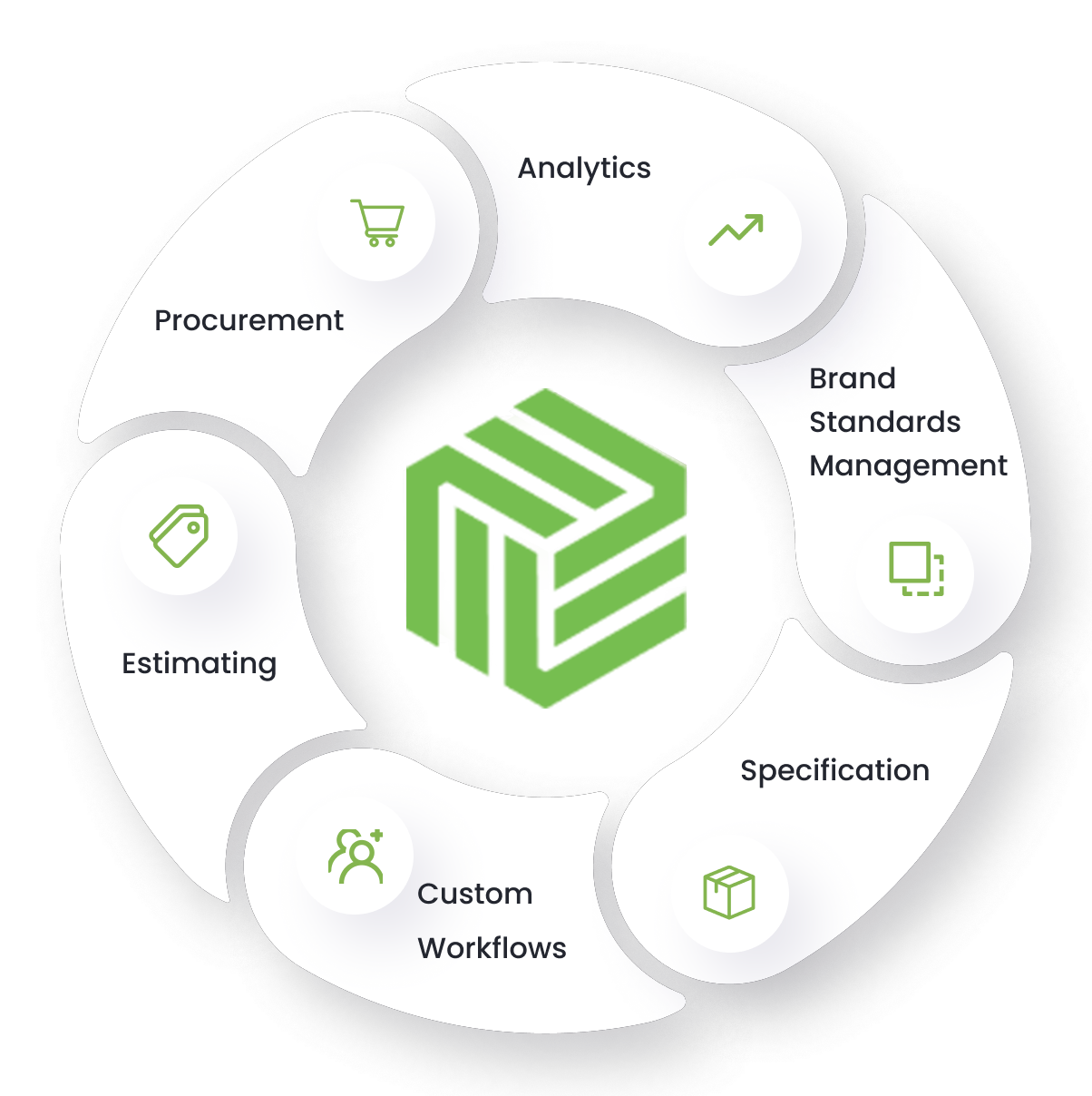New: More Power and Flexibility For Your Procurement Workflow
Manage FF&E specification, procurement, and product data at scale. Take on bigger projects with confidence and grow your firm with Fohlio. Automate...

Specify and procure FF&E and OS&E at scale with Fohlio today. Empower teams to move faster and improve their operational workflow with specification, prototyping, procurement, collaboration, and analytics tools.
Turnover is a fact of life. But if your project knowledge walks out the door with every key staff member, you're gambling with long-term compliance, cost, and institutional continuity.
We’ve seen it firsthand: clients returning to renovate facilities a decade later, only to discover they have no idea what finish was used in a critical area because it was never properly documented.
That’s not just a paperwork problem. It’s a costly, time-consuming rework issue that can delay renovations, stall approvals, and wreck budgets.
Good documentation and internal libraries don’t just make your current work easier—they safeguard your future. They make renovations, audits, and expansions smoother, faster, and far less painful. And they ensure that the knowledge you build stays with your organization, not just your people.

Image Description:
Construction site for the Townsville University Hospital Expansion in Queensland, Australia — a high-profile example of a healthcare infrastructure project facing delays. Initially budgeted at $530 million, the project’s scope and cost have ballooned to over $1 billion, with completion now projected for 2029. A government review found the original plan “undeliverable,” prompting a full-scale redesign and revised strategy.
Source: Queensland Government Ministerial Media Statement
You already know staff turnover slows down current projects. But here’s what often gets missed: its long tail.
A spec missed today because of bad handoff? That becomes a sourcing nightmare five years from now when you're renovating.
A decision made in a hallway conversation with no written follow-up? That's a compliance liability in a decade.
Here's what long-term fallout from turnover looks like:
Missing historical specs: You go to replace tiles during a renovation—and realize no one knows the make, color, or sizing of the originals, and which vendor they were bought from. They're impossible to match, and now you're staring down a costly full-floor redo.
Lost vendor context: A product needs replacing, but the original vendor contact is long gone, the quote is buried in someone’s inbox from 2014, and the model? Discontinued. Worse, you’re chasing down a ghost product—no documentation, no alternates, and no easy way to avoid ripping and replacing with something completely new.
Redundant rework: Your new team spends weeks re-researching and reselecting the exact same light fixtures, flooring materials, and casework your last team had already decided on—sometimes even repurchasing them. And worse, you miss out on warranties tied to those original selections—ones that could’ve saved thousands on replacements, but went unused because no one knew they existed or how long they lasted. That’s not just inefficiency—it’s leaving money and time on the table.
These aren't hypothetical. They're what happens when there's no centralized system capturing decisions, specs, and documentation.
.webp?width=1056&height=444&name=65e078b669347aec46a6eca9_p-3-7%20(1).webp)
Think of your internal library as the long-term brain of your organization’s capital projects—a library that stores all the information related to your FF&E and medical equipment, including specs, vendor details, documentation, and usage history across every project.
Your lead FF&E planner may leave, but the specs they used for every exam room in the last five projects? Still searchable—because they're stored in a centralized internal library built inside Fohlio. That includes model numbers, vendor info, warranty documents, and the why behind each selection, not just the what. It's not just searchable; it's strategically preserved.
New team members don’t waste weeks digging through old folders or guessing how things were done. The right data is one search away—because in Fohlio, collaboration tools let you control exactly who sees what.
Facility managers can view warranties and vendor contacts for anything that needs replacing. Purchasing teams and CFOs?
They get a clear view of the total cost across every room type—MRI suites, consultation rooms, waiting areas. Everyone sees the slice of information they need, without sifting through what they don’t. That means onboarding is faster, decisions are clearer, and no one is stuck rebuilding from scratch.
No more mismatched door handles between campuses. If you standardize once, you can reuse over and over—down to the exact model, finish, and supplier.
And with Fohlio, that consistency is role-specific. Architects can stick to the approved design palette, procurement sees sourcing history and bulk pricing, and facilities teams access exact install notes and warranty details.
That way, whether you're building a new site or replacing worn-down components, everyone is working from the same trusted source.
Need to rebid a package for 12 clinics? Pull historical data, compare performance, and negotiate from a place of strength. Even if you purchased your FF&E piece by piece from multiple vendors, Fohlio lets you aggregate that information across every project. You can filter by supplier, see how much you've ordered, how often, and what it cost.
 That level of transparency doesn’t just help you stay organized—it gives you serious leverage. Instead of rebidding blindly, you're negotiating with clarity, armed with usage history and spend volume that turns one-off orders into strategic buying power.
That level of transparency doesn’t just help you stay organized—it gives you serious leverage. Instead of rebidding blindly, you're negotiating with clarity, armed with usage history and spend volume that turns one-off orders into strategic buying power.
Fohlio's internal library lets you update an item once, then push that change across every live project using it. That means even if your lead specifier retires tomorrow, your standard faucet spec doesn’t retire with them.
Every selection and product decision you store in Fohlio becomes more than a record—it becomes strategic leverage.
Lifecycle data tracks the history and performance of your materials and equipment: how long they last, how often they require maintenance, and how frequently they’ve been replaced. Over time, this gives you insight into what’s delivering long-term value.
Let’s say your facility team notices one type of exam table lasts twice as long as another. That information doesn’t just influence maintenance schedules—it shapes future purchasing standards. If one model consistently drives up service calls or part replacements, your spec library reflects that and helps you avoid the same mistake systemwide.
And when leadership asks for ROI on FF&E selections? You can pull real data—down to cost-per-use—to justify smarter capital planning. With lifecycle tracking, your internal library becomes a feedback loop for building stronger standards, not just storing them.
Read: 3 Ways Lifecycle Data Will Massively Increase Your Building’s Value
Documentation isn't just for the here and now. It's the only way to maintain continuity across years of work, across dozens of hands.
Without it, you’re not future-proof. You’re future-fragile.
Why a product was selected. Not just what it is, but the reasoning behind it (cost, performance, vendor relationship).
How approvals happened. Screenshots, signatures, timestamps—you want a trail.
Design intent. Not just drawings, but notes on purpose: "This was laid out for bariatric access," or "This sink model fits with our water-saving policy."
Change history. What got swapped out, when, and why.
These details save future you (or someone else) hours of digging, guessing, and second-guessing.
Related: Create Accurate Submittals and Firm-Wide Standard Reports in 2 Steps
Let’s get specific. Here's what happens when internal documentation and libraries don’t exist:
You re-spec the same light fixture five times. Because the spreadsheet was lost.
You can't replicate the layout from your flagship clinic. Because no one documented which exam room version it used.
Your next renovation hits delays. Because the original product has been discontinued, and you can't figure out what the approved alternates were.
Approvals get repeated. Because no one trusts undocumented decisions, so leadership wants to see it all again.

Whether you're using Fohlio or not, here are the keys to making your projects turnover-proof:
Specs, vendor info, warranties, documents, mood boards, procurement history—put everything in a single platform.
In Fohlio, this means one cloud-based workspace where teams across design, construction, procurement, and operations can all access the same trusted data. This eliminates version confusion, siloed spreadsheets, and hours spent chasing PDFs from five years ago.
Instead of organizing files by project, create reusable libraries of your best templates, room types, and product selections. In Fohlio, you can tag and group items into Product Blocks for patient rooms, consultation rooms, admin areas—you name it. These can be dragged into any new build or renovation, keeping standards consistent and speeding up kickoff.
Always know who changed what and when. In Fohlio, every edit is logged and traceable. You can view old versions of specs, see who approved them, and restore earlier entries when needed. That means no more second-guessing what the “final” file is—or who changed the vendor on that $40K imaging table.
Make sure the right people can edit and approve—while everyone else has access to the info they need, without introducing risk.  In Fohlio, you can filter views by user role: Facility managers see warranties and replacement schedules; purchasing sees cost breakdowns by supplier and space; leadership sees roll-up dashboards. Everyone stays in their lane—but on the same highway.
In Fohlio, you can filter views by user role: Facility managers see warranties and replacement schedules; purchasing sees cost breakdowns by supplier and space; leadership sees roll-up dashboards. Everyone stays in their lane—but on the same highway.
Don’t just show them where the kitchen is. On day one, walk them through how to search your spec library, review past project packages, and navigate dashboards. With Fohlio, new team members can filter by project type, date, or supplier to quickly get oriented and make confident decisions—without repeating work that was already done.
A system is only turnover-proof if everyone knows how to use it. Invest in making that part of your onboarding culture.
If this sounds familiar, it should. In our guide to future-ready FF&E planning, we talked about planning for flexibility and reuse across projects.
This blog is the other half of that coin. It’s not just about planning for multiple locations—it’s about planning for multiple generations of team members.
You’re not just future-proofing your design. You’re future-proofing your people. So the next time a procurement lead moves on or a facility director retires, your project doesn’t start from scratch.
Turnover is inevitable. Knowledge loss doesn’t have to be.
When your specs, rationale, and standards live in a searchable, centralized library, your projects survive whatever staffing changes come next.
Future-proof your projects. And your process.
Your future team will thank you for it.
Specify and procure FF&E and OS&E at scale with Fohlio today. Empower teams to move faster and improve their operational workflow with specification, prototyping, procurement, collaboration, and analytics tools.
Learn how to:
Manage FF&E specification, procurement, and product data at scale. Take on bigger projects with confidence and grow your firm with Fohlio. Automate...
Manage FF&E specification, procurement, and product data at scale. Take on bigger projects with confidence and grow your firm with Fohlio. Schedule a...
Manage FF&E specification, procurement, and product data at scale. Take on bigger projects with confidence and grow your firm with Fohlio. Automate...